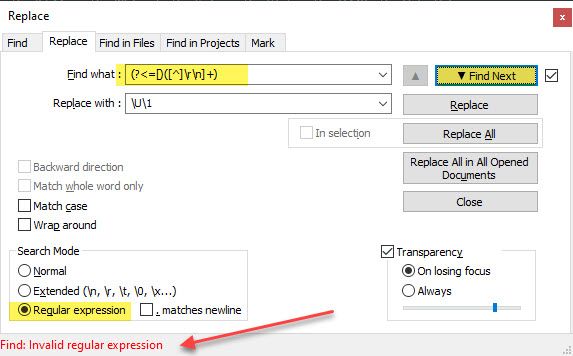

- #Regular expressions using brackets text editor portable
- #Regular expressions using brackets text editor code
- #Regular expressions using brackets text editor plus
- #Regular expressions using brackets text editor windows

Replace All replaces all instances of the highlighted text. Replace replaces only the text that is highlighted dark blue. Replaces the specified string with another string. Opens the font dialog and changes the editor font.įinds the next instance of a string in the text.įinds the next instance of the string that was specified previously in the Find dialog. invalid parameters/attributes are shown in red.If FME syntax highlighting is selected, then: Sets the highlighting scheme to the given language. Inserting Extended ASCII characters using Macintosh.
#Regular expressions using brackets text editor windows
Inserting Extended ASCII characters using Windows.On Macintosh, extended ASCII characters are inserted with a keystroke combination that includes the Opt key, or the Opt and Shift keys together.
#Regular expressions using brackets text editor code
On Windows, these characters are inserted by holding the Alt key while typing the corresponding character code on the numeric keypad (usually on the right side of the keyboard do not type the numbers that appear on the main part of the keyboard). The Advanced editor supports inserting extended ASCII printing characters and non-printing control characters. In this example, the value of the ParkName feature attribute is converted to upper case:

\n back reference by group number (n >= 1) In this case, a subexp call can not be performed although Not only a name but a number is assigned like a capturedĪssigning the same name as two or more subexps is allowed. (All characters of the name must be a word character.) (?imx-imx:subexp) option on/off for subexp Word Letter | Mark | Decimal_Number | Connector_Punctuation Space Space_Separator | Line_Separator | Paragraph_Separator | Punct Connector_Punctuation | Dash_Punctuation | Close_Punctuation |įinal_Punctuation | Initial_Punctuation | Other_Punctuation | Graph ] & ^Control & ^Unassigned & ^Surrogate Word alphanumeric, "_" and multibyte charactersĬntrl Control | Format | Unassigned | Private_Use | Surrogate Print include all of multibyte encoded characters Graph include all of multibyte encoded characters In a character class, you should escape these characters by '\'. * If you want to use '' as a normal character intersection (low precedence at the next of ^)Įx. set (character class in character class) negative class (lowest precedence operator) \Z end of string, or before newline at the end
#Regular expressions using brackets text editor plus
The basic quantifiers are the asterisk ( *) to specify that the match should happen zero or more times, plus ( +) for one or more times, or a range can be given as + are possessive op. ) will match any character (except newline). Something like \w will match word characters, where \s will match whitespace characters (space, tab, newline, etc.). Instead we use regular expressions which describe the match as a string which (in a simple case) consists of the character types to match and quantifiers for how many times we want to have the character type matched.įor example normal letters and digits match literally.
#Regular expressions using brackets text editor portable
Naively we could write a small program to match text, but this is error-prone, tedious and not very portable or flexible. A regular expression is a domain specific language for matching text.


 0 kommentar(er)
0 kommentar(er)
